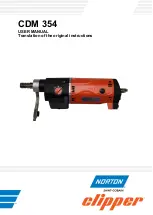
Fig. 1
Fig. 2
Fig. 3
Fig. 4
OPERATIONS INSTRUCTIONS
Note
:
Before using the tool, read the instruction
book carefully.
INTENDED USE
This impact drill shall be used for drilling metal or
wood or similar materials and for impact drilling of
concrete or similar materials.
Other uses for the tool will lead to the damage of the
tool and a series of dangers to the operator. This tool is
intended for DIY home use , or occasional professional
use.
1. INSTALLING THE AUXILIARY HANDLE
& DEPTH GAUGE
Loosen the handgrip anti-clockwise then insert the
depth gauge through hole in handle to required depth.
Slide the handle on the head of the drill (Fig. 1).
Rotate the handgrip clockwise to clamp the handle and
tighten fully (Fig. 2). The depth gauge can be used to
set a constant depth to drill.
Note:
Use the auxiliary handle where possible to gain
extra control and to prevent fatigue.Hold the tool firmly
to control the twisting of the tool.
2. INSERT DRILL BITS
Turn by hand the chuck of the drill in a counter
clockwise direction to open it (Fig. 3). Then insert the
drill bit inside and turn the chuck in a clockwise
direction and grip the rear chuck sleeve at the same
time. The chuck is also integrated with a locking device
to prevent bit loosening in use (Fig. 4).
3. SPEED ADJUSTMENT
Two speed selector
(Fig. 5)
Choose position 1 for high torque/low speed range for
large diameter drill bits.
Choose position 2 for low torque/ high speed range for
small diameter drill bits.
Note:
Never change the gears when the tool is
rotating, wait until it has stopped.
Fig. 5
Fig. 6
Fig. 7
a
b
c
d
c
Nota:
No cambie nunca las marchas mientras la herrami-
enta esté girando, espere a que la unidad se detenga.
Interruptor de velocidad variable
(Fig. 6)
Esta herramienta cuenta con un interruptor de
velocidad variable (a) que proporciona una velocidad y par
de torsión más altos a mayor presión sobre el gatillo. La
velocidad se controla mediante la cantidad de presión
aplicada sobre el gatillo. La función de velocidad variable
es particularmente útil al iniciar el taladrado. También le
permite seleccionar la mejor velocidad para una aplicación
determinada. Para limitar la velocidad máxima de la
herramienta, gire la rueda (b) de la parte frontal del gatillo
hasta alcanzar el ajuste deseado.
4. ENCENDIDO Y APAGADO
(Fig. 6)
Arranque la herramienta apretando el gatillo del interruptor
de velocidad variable (a). Para detener la herramienta,
suelte el gatillo. Si presiona el botón de bloqueo (d)
mientras el gatillo está presionado, éste se mantendrá en
la posición actual. Esto es útil cuando se necesita usar el
aparato continuamente durante períodos de tiempo
extendidos.
Para liberar el botón de bloqueo (d), pulse y suelte el gatillo
del interruptor (a).
5.CONTROL DEL SENTIDO DE ROTACIÓN
(Fig. 7)
El control del sentido de rotación (c) determina el sentido
de giro de la herramienta. Para seleccionar la rotación
hacia adelante para un taladrado normal, pulse el botón del
control de sentido de rotación (c) tal como se indica (Fig.
7). Use la rotación inversa solo cuando necesite liberar una
broca atascada.
Nota:
Al cambiar la posición del control de sentido de
rotación (c), asegúrese de que el gatillo está en reposo y el
motor está detenido.
6. TALADRADO Y TALADRADO CON
PERCUTOR
Si quiere activar la función de taladrado (para taladrar
metal, madera o plástico), ponga el selector en posición de
taladrado.
Si quiere activar la función de taladrado con percutor (para
taladrar paredes u hormigón), ponga el selector en posición
de martillo (Fig. 8).
Fig. 8
Fig. 5
Fig. 6
Fig. 7
a
b
c
d
c
Note:
Ne jamais changer de vitesse quand l’outil est en
rotation, attendez qu’il soit complètement arrêté.
Interrupteur de vitesse variable
(Fig. 6)
Cette perceuse possède un sélecteur de vitesse variable
(a) qui délivre une vitesse plus élevée et un plus grand
couple quand on augmente la pression sur la gâchette.
La vitesse varie selon la pression exercée sur la gâchette.
Cette fonction est particulièrement utile lorsqu’on
commence à percer. Cela permet également de
sélectionner la meilleure vitesse pour une application
particulière. Pour limiter la vitesse maximale de l’outil,
tourner la molette (b) située sur la gâchette.
4. DEMARRAGE ET ARRET
(Fig. 6)
Démarrer l’outil en appuyant sur la gâchette (a). Relâcher
la gâchette pour arrêter l’outil. Si vous pressez le bouton de
blocage (d) en appuyant sur la gâchette en même temps,
l’outil fonctionne en continu. Ce système est utile pour
travailler en continu pendant des périodes plus longues.
Pour relâcher le bouton de blocage(d), appuyer puis
relâcher la gâchette (a).
5.SELECTEUR DU SENS DE ROTATION
(Fig. 7)
Le sélecteur du sens de rotation (c) détermine la direction
de rotation de l’outil. Pour sélectionner la rotation avant
pour des opérations normales de perçage, pousser le
sélecteur (c) comme indiqué (Fig. 7).
Utiliser la rotation en sens inverse pour libérer un foret
coincé uniquement.
Note:
Quand vous changez la position du sélecteur (c),
assurez-vous que la gâchette est relâchée et que le moteur
est arrêté.
6. PERCAGE ET PERCAGE EN
PERCUSSION
Si vous désirez activer la fonction de perçage (pour le
perçage du métal, du bois ou du plastique), placer le
sélecteur sur la position « perçage »
Si vous désirez activer la fonction de perçage en percus-
sion (pour le perçage du béton), placer le sélecteur sur la
position « percussion» (Fig. 8).
Fig. 8
































